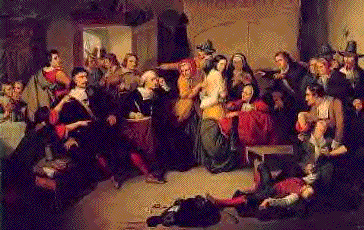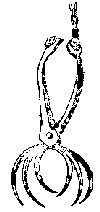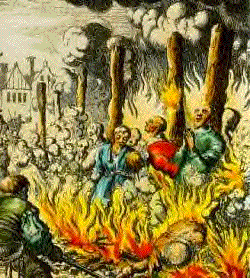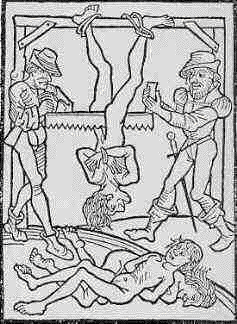Behold The Mystery | home
|
The Burning Times
 |
 Answer these questions.
|
1.) Do you have a birthmark, mole, disfigurement, or do you even have a pimple?
2.) Are you a liberal type?
3.) Do you like to dance?
4.) Do you have a pet cat, mouse, snake, goat?
5.) Do you own a broom?
6.) Do you speak out against what you don't believe is right?
7.) Do you sometimes give your husband or mother grief or do you "obey his/her every command like you should?"
8.) Have you ever had any enemies or just someone who didn't think highly of you?
9.) Have you ever lived near someone that lost their job? Had a pet that died? Had a bad crop? Had a family member that died? That got sick?
10.) Have you ever gone out for a walk by yourself after nightfall?
11.) Has there ever been a hail storm or even a wicked thunder storm in the same area that you live?
|
 Answering yes to just one of these questions would have gotten you tried, persecuted, tortured and either hung or burned at a stake between the dates of 1100-1700. Men, women, children, the elderly, the crippled and even pets, all ended up as victims during the Witch Craze,
(aka The Burning Times and Witch Hunts/Craze).
More middle-aged women than any other were tortured and killed though.
|
Torture
|
Although alleged witches were burned alive or hung over a five century interval -- from the 14th to the 18th century -- The total number of victims was probably between 50,000 and 100,000 -- not 9 million as many believe.
the vast majority were tried from 1550 to 1650.
Some of the victims worshiped Pagan deities, and thus could be considered to be indirectly linked to today's Neopagans. However most apparently did not.
Some of the victims were midwives and native healers; however most were not Witches.
Most of the victims were tried executed by local, community courts, not all by the Church.
The Great Witch Hunt was not an effort by Christian authorities to stamp out Paganism. For all intents and purposes, that had been accomplished long before.
|
The victims of the Great Witch Hunt, which took place in the midst of religious battles between Catholics and Protestants during the Reformation, weren't all witches, or Goddess-worshippers, or Pagans.
They tended to be old widowed women who were perceived as a burden on the community, out-spoken younger women who were perceived as a threat to the authorities, sexually promiscuous women, or women whose socio-economic power was a source of envy or fear.
The form of "witchcraft" these women were falsely accused of was Satanic,
Not Pagan. The most popular accusation was that hey fornicated with the Devil.
Under torture, they often admitted to participating in forms of "the black mass"
|
 The spider was used in mastectomies. It was heated until the iron was red and used to mutilate and tear a woman's breasts off.
Some tortures were devised with women specifically in mind. Mastectomy was one of them. Although both men and women could have the skin torn off them with red- or white-hot pincers, mastectomy was a distinctly feminine device.
One torture manual recommended particular attention be paid to female breasts as they are "extremely sensitive, on account of the refinement of the veins."
Mastectomy first became popular in 1599 Bavaria. The most famous case is that of Anna Pappenheimer.
After already being tortured with the strappado, a public demonstration was in order. Anna was stripped, her flesh torn off with red-hot pincers, and her breasts cut off. As if this was not enough,
|
 It was once commonly believed that a witch's power could be nullified by blooding her or by destroying her blood in a fire, hence the practice of burning at the stake. Sometimes uncooperative witches were burned with green wood, which took longer to kill them. Jacques de Molay, the Grand Master of the Templars, was "slow roasted on a spit"
By far the most well-known punishment for witches was death by burning,
a fate reserved also for heretics.
|
 One 'foolproof' way to establish whether a suspect was a witch was ducking. With right thumb bound to left toe, the accused was plunged into a convenient pond. If he or she floated it proved an association with the black arts, with the body rejecting the baptismal water. If the victim drowned they (sic) were innocent.
Given the curious position of the prisoner, it was more likely they would float
|
 Hanging was a popular way of doing away with witches, particularly in England and Salem, Massachusetts. Approximately 1000 people were hanged for witchcraft in England. Of these, about 400 were hanged over a 14-month period
|
 This inverted position, which assures ample oxygenation of the brain and impedes the general loss of blood,
the victim does not lose consciousness until the saw reaches the navel--and even the breast, if one is to believe accounts of the early eighteen-hundreds
This horrible method of execution was used on French witches
"pregnant by Satan."
|
The Burning Times were a sad reality of history.
However, it was not true Christians that persecuted those accused of Witchcraft, as they were persecuted themselves, by an evil and apostate Church masquerading under the banner of Christianity. Even those who fitted the more expected idea of what a Witch was, were often not real Witches,
certainly not in the modern sense of the word.
|
